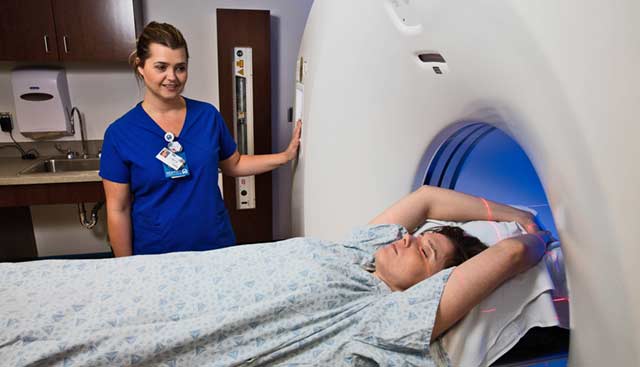Cervical Cancer Screening

Cervical cancer originates in the cells of the cervix, which is the lower part of a woman’s uterus that connects to her vagina. When precancerous cells are detected in the cervix, cervical cancer can often be prevented. Additionally, when the malignancy is detected early, it can often be effectively treated and even cured.
Because cervical cancer typically does not produce noticeable symptoms until the tumor reaches an advanced stage, testing for cervical cancer aimed at prevention and early detection plays an essential role in women’s healthcare.
How do you screen for cervical cancer?
Cervical cancer screening tests can identify abnormal changes in the cells of the cervix that could potentially develop into cancer if left untreated. Some commonly used screening tests that can help prevent cervical cancer and detect early-stage tumors include:
Physical exam
A physician examines the woman’s uterus, vagina, ovaries, fallopian tubes, bladder and rectum to check for lumps, masses and other abnormalities. During a pelvic exam, the physician will not be able to see precancerous changes (dysplasia) in the woman’s cervix. However, the physician may be able to see signs of invasive cancer. Any suspicious findings will be further evaluated during follow-up cervical cancer testing.
Pap (Papanicolaou) test
Also known as a Pap smear, a Pap test can be performed in a physician’s office. Using a plastic or metal instrument (speculum), the physician will gently separate the walls of the woman’s vagina to better visualize and access her cervix. Using a small brush, the physician will collect a small sampling of cells and mucus from the surface of the woman’s cervix. The sample will then be sent to a lab for cervical cancer testing. The results of the Pap test can help the physician identify cellular changes on the woman’s cervix that could progress into cervical cancer if left untreated.
HPV (human papillomavirus) test
Similar to a Pap test, an HPV test evaluates a small sample of cells taken from the surface of the woman’s cervix. HPV infections are common, and most are easily treated and not a cause for alarm. However, certain HPV strains can cause cellular changes that lead to cervical cancer if the infection is undetected and untreated. Therefore, a physician might suggest that an HPV test be performed along with a Pap test to gain a more comprehensive picture of the woman’s cervical health.
How often should I have a cervical cancer screening?
Current guidelines suggest that most women should begin routine cervical cancer screenings at age 21. Between ages 21 and 30, a woman should have a Pap test performed once every three years. If a Pap test produces an abnormal result, it should be followed up with an HPV test.
Between ages 30 and 65, a woman should have a Pap test for cervical cancer screening performed once every three years. However, if the Pap test is performed along with an HPV test, the testing frequency can be reduced to once every five years.
After age 65, a woman’s physician may advise that she can discontinue her routine cervical cancer screenings if her test results have been consistently normal.
Women who have had a hysterectomy and have no history of cervical cancer or pre-cancer do not need to be screened for cervical cancer. On the other hand, women who have a heightened risk of developing cervical cancer may require more frequent testing.
If atypical squamous cells are detected in a Pap smear, follow-up testing such as a biopsy may be needed to determine the underlying cause.
Can cervical cancer be seen on ultrasound?
A cervical cancer diagnosis requires a biopsy. Therefore, a physician cannot conclusively determine whether a tumor is cancerous based on the results of ultrasound testing alone. However, ultrasound can provide highly accurate information about the local extent of a cervical tumor. This advanced imaging technique uses high-frequency sound waves to create detailed images of the body’s internal structures, and it does not involve radiation exposure or require the use of a contrast medium.
After a physician confirms a cervical cancer diagnosis with a biopsy, the physician may order an abdominal or pelvic ultrasound to further examine the woman’s cervix. A pelvic ultrasound can be performed transabdominally by placing the probe on the woman’s abdomen, or transvaginally by placing the probe in her vagina.
Cervical cancer screening at Moffitt Cancer Center
Women who are interested in cervical cancer screening, have received an abnormal test result or are experiencing cervical cancer symptoms are welcome to consult with the outstanding board-certified physicians in the Gynecologic Oncology Program at Moffitt Cancer Center. As a recognized leader in the development of scientific technology for detecting and treating cancer, we offer our patients convenient access to the latest diagnostic techniques as well as a wide range of treatment options, including a robust clinical trials program, in a single location.
To learn more about cervical cancer screening, please contact Moffitt Cancer Center at 1-888-663-3488. Or, if you prefer, you can complete our new patient registration form online. We will be pleased to see you with or without a referral. As Florida’s top cancer hospital, we are changing the model, and we are providing every new patient with rapid access to a cancer expert as soon as possible, which is faster than any other cancer hospital in the nation.
References
Centers for Disease Control and Prevention – Cervical Cancer – Basic Information
American Cancer Society – Ultrasound for Cancer
Screening
